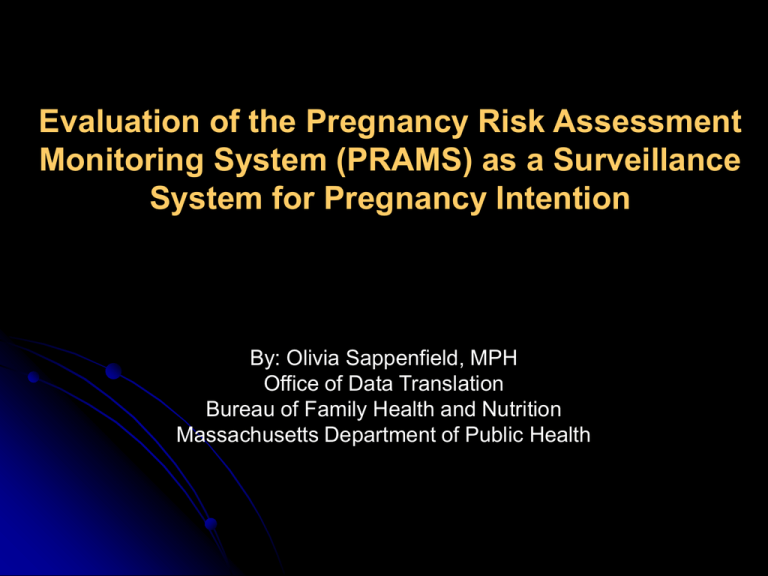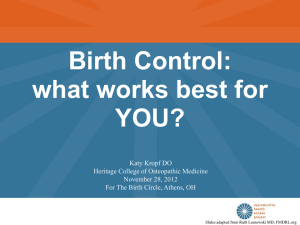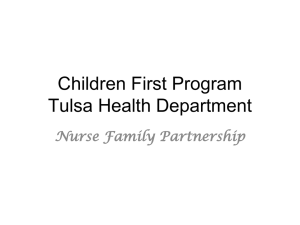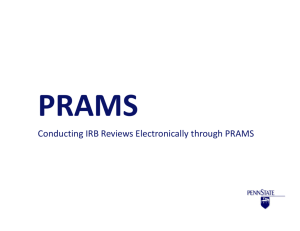
Evaluation of the Pregnancy Risk Assessment
Monitoring System (PRAMS) as a Surveillance
System for Pregnancy Intention
By: Olivia Sappenfield, MPH
Office of Data Translation
Bureau of Family Health and Nutrition
Massachusetts Department of Public Health
Unintended Pregnancy
All pregnancies wanted later or not at all
Association with poor birth outcomes including
preterm birth, low birth weight (LBW), and small for
gestational age (SGA)1-4
Association with delayed and inadequate prenatal
care, continued drinking, continued smoking during
pregnancy1-4
Represent about ½ of all births nationally
Cost more than $9 billion annually5,6
Risk Factors
Maternal race/ethnicity, maternal age, maternal
education, household income, marital status
Partner’s intention, desirability of partner, number of
partners, contraceptive use
Pregnancy Intention in Massachusetts
State and Title V priority: “Support reproductive
and sexual health by improving access to
education and services”
Traditionally reported using Behavioral Risk
Factor Surveillance System (BRFSS)
State priority measure: “The percentage of pregnancies
among women age 18 and over that are intended ”
Pregnancy intention asked every other year
Queries about pregnancies up to 5 years ago
PRAMS offers a valuable alternative
Data used to inform the Title V Block Grant and reports
Queries about pre-pregnancy contraceptive use
PRAMS
Population-based data on maternal attitudes and
behaviors before, during, and shortly after
pregnancy
Sampled from birth certificate file
Data collection began in 2007
80 questions (54 core, 16 standard, and 10 MAspecific)
Includes a mail and phone phase
Administered 2-6 months postpartum
English and Spanish surveys only
Methods
Adapted CDC’s “Updated guidelines for evaluating
public health surveillance systems”
PRAMS stakeholder surveys
Initially developed for infectious disease surveillance
systems
Usefulness and acceptability of PRAMS to monitor
pregnancy intention
PRAMS staff surveys
Analytical comparison of BRFSS and PRAMS
Dependent variable: pregnancy intention
Independent variables: maternal age, maternal
race/ethnicity, maternal education, marital status, and
household income
Methods Continued
Pregnancy intention definition:
Unintended: wanted later or not at all
Intended: wanted then or sooner
PRAMS question:
Thinking back to just before you got pregnant with your
new baby, how did you feel about becoming pregnant?
BRFSS questions:
1) Have you been pregnant in the last 5 years
2) Thinking back to your last pregnancy, just before you
got pregnant, how did you feel about becoming pregnant?
Chi-square tests to determine similarity of population
from year to year
Inability to link data to assess sensitivity and PPV
Confidence interval overlap, means no significant
difference
Results
Table 1. Descriptive characteristics of Massachusetts women (PRAMS
2008/2010, n= 2877; BRFSS 2008/2010, n=683)1
PRAMS 08/10
BRFSS 08/10
n
%
n
%
2887
100.0%
683
100.0%
Intended
1885
69.0%
500
80.0%
Unintended
1002
31.1%
183
20.0%
18-24 years
621
20.9%
54
5.5%
25-34 years
1680
57.6%
290
40.3%
35-44 years
586
21.6%
315
54.2%
NH White2
861
69.0%
462
78.3%
NH Black2
634
8.7%
45
4.8%
Hispanic2
703
14.0%
122
10.3%
NH Asian/Pacific Islander (PI)2
604
8.3%
32
6.6%
Overall
Pregnancy Intention
Maternal Age
Maternal Race/Ethnicity
1Weighted
Percents
2non-Hispanic
Table 1 Continued
PRAMS 08/10
BRFSS 08/10
n
%
n
%
<High School
342
8.9%
52
4.1%
High School
732
25.7%
131
16.9%
Some College
623
19.6%
163
21.2%
1178
45.9%
337
57.9%
Married
1777
66.3%
445
77.5%
Not married
1110
33.7%
238
22.6%
<185% Federal Poverty Level (FPL)
1257
38.3%
220
26.4%
185+% FPL
1346
61.7%
359
73.6%
Maternal Education
College or higher
Marital Status
Household Income
1Weighted
Percents
Table 2. Descriptive characteristics of sample population by
pregnancy intention (PRAMS 2008/2010, n= 3022; BRFSS
2008/2010, n=683 )1
PRAMS 2008/2010
Intended
n
Overall
%
1885 100.0%
BRFSS 2008/2010
Unintended
n
%
1002 100.0%
Intended
n
%
500 100.0%
Unintended
n
%
183 100.0%
Maternal Age
18-24 years
267
12.9%
354
38.7%
19
1.9%
35
19.8%
25-34 years
1166
61.8%
514
48.1%
200
40.4%
90
40.0%
35-44 years
452
25.3%
134
13.2%
261
57.7%
54
40.2%
Maternal Race/Ethnicity
NH White2
630
72.8%
231
60.6%
366
81.6%
96
65.4%
NH Black2
338
6.6%
296
13.4%
25
3.5%
20
10.2%
Hispanic2
415
12.0%
288
18.6%
72
8.3%
50
18.3%
NH Asian/PI2
446
8.6%
158
7.5%
23
6.7%
9
6.2%
1Weighted
Percents
2non-Hispanic
Table 2 Continued
PRAMS 2008/2010
Intended
n
Overall
%
1885 100.0%
BRFSS 2008/2010
Unintended
n
%
1002
100.0%
Intended
n
%
Unintended
n
500 100.0% 183
%
100.0%
Maternal Education
<High School
197
7.1%
145
12.7%
28
2.7%
24
9.7%
High School
400
21.5%
332
35.0%
83
14.1%
48
28.0%
Some College
344
16.3%
279
26.9%
111
20.4%
52
24.1%
College≤
934
55.1%
244
25.5%
278
62.8%
59
38.2%
1354
77.4%
423
41.6%
381
85.5%
64
45.2%
531
22.6%
579
58.4%
119
14.5% 119
54.8%
<185% FPL
666
28.8%
591
59.7%
131
21.5%
89
48.1%
185+% FPL
1047
71.3%
299
40.3%
305
78.5%
54
51.9%
Marital Status
Married
Not married
Household Income
1Weighted
Percents
Table 3. Comparison of unintended pregnancy prevalence
among MA PRAMS and BRFSS respondents (PRAMS
2008/2010, n= 1019; BRFSS 2008/2010, n=183 )1
PRAMS 2008/2010
BRFSS 2008/2010
Unintended Pregnancy
Unintended Pregnancy
%
95% CI
%
95% CI
Maternal Age
18-24 years
57.5%
51.8% 63.0%
71.9%
49.2%
87.2%
25-34 years
26.0%
23.3% 28.8%
19.8%
14.6%
26.3%
35-44 years
19.0%
15.2% 23.5%
14.8%
10.6%
20.4%
NH White
27.2%
24.1% 30.6%
16.7%
12.7%
21.8%
NH Black
47.6%
43.8% 51.5%
42.3%
24.5%
62.3%
Hispanic
41.0%
37.5% 44.7%
35.6%
23.7%
49.6%
NH Asian/PI
28.0%
24.5% 31.8%
19.0%
8.2%
38.2%
Maternal Race/Ethnicity
1Weighted
Percents
2non-Hispanic
Table 3 Continued
PRAMS 2008/2010
BRFSS 2008/2010
Unintended Pregnancy
Unintended Pregnancy
%
95% CI
%
95% CI
Maternal Education
<High School
44.5%
37.3%
52.0%
47.8%
24.4% 71.8%
High School
42.4%
37.3%
47.7%
33.3%
22.2% 46.5%
Some College
42.6%
37.4%
48.1%
22.7%
15.1% 32.7%
College or higher
17.3%
14.7%
20.2%
13.2%
9.5% 18.0%
Married
19.5%
17.3%
21.9%
11.7%
8.4% 15.9%
Not married
53.8%
49.5%
58.1%
48.6%
38.8% 58.5%
<185% FPL
48.0%
43.9%
52.0%
33.7%
25.1% 43.6%
185%+ FPL
20.1%
17.5%
23.0%
13.0%
9.3% 17.9%
Marital Status
Household Income
1Weighted
Percents
Other Attributes
Flexibility
Timeliness
Response rate consistently above 65%
Question response rate between 97.5% and 95%
Representativeness
2-6 months postpartum vs. up to 5 years postpartum
Women surveyed postpartum – recall bias
Data Quality
PRAMS conducted annually
States able to include state-specific questions
CDC changes to core questions (Phases)
Can adapt to add questions on emerging issues (e.g. H1N1)
Population-based, oversamples by race/ethnicity
Deliveries ending in live birth
Other Attributes: Simplicity, Acceptability, and Stability
Conclusion: PRAMS is an Acceptable
System for Monitoring Pregnancy Intention
Considered an acceptable data source by researchers and
by its study population
Timely surveillance system for state-level data on
postpartum women
Prevalence of unintended pregnancy overlapped for all
indicators except <185%FPL and certain subgroups
(married, some college education, and NHW)
Concern because poorer women are more at risk of unintended
pregnancy
Similarly represented less educated women and minority women,
who are also more at risk
Can provide estimates for the magnitude of morbidity
associated with pregnancy intention
Inform reproductive health programs
Used in home-visiting programs to assist in developing reproductive
life plans
Strengths and Limitations of
PRAMS
Retrospectively collects data-recall bias
Currently no “partner questions”
Collects data soon after delivery
Capable of detecting trends that signal changes in
pregnancy intention
Ability to change PRAMS questions every year
Does not collect data on fetal death,
spontaneous abortion, or induced abortion
Live births used for family planning programs
Live births used for population contraceptive need
References
1.
2.
3.
4.
5.
6.
D'Angelo D.V., Gilbert B.C., Rochat R.W., Santelli J.S., Herold J.M.
Differences between mistimed and unwanted pregnancies among
women who have live births. Perspectives on Sexual and
Reproductive Health. 2004;36(5):192-7.
Kost K., Landry D.J., Darroch J.E. The effects of pregnancy planning
status on birth outcomes and infant care. Family Planning
Perspectives. 1998;30(5):223-30.4.
Sable M.R., Spencer J.C., Stockbauer J.W., et al. Pregnancy
wantedness and adverse pregnancy outcomes: differences by race
and medicaid status. Family Planning Perspectives. 1997;29:76-81.
Shah P.S., Balkhair T., Ohlsson A., et al. Intention to become
pregnant and low birth weight and preterm birth: a systematic review.
Maternal and Child Health Journal. 2011;15:205-16.
Finer L.B., Kost K. Unintended pregnancy rates at the state level.
Perspectives on Sexual and Reproductive Health. 2011:43(2):78-87.
Monea E., Thomas A. Unintended pregnancy and taxpayer
spending. Perspectives on Sexual and Reproductive Health.
43(2):88-93.
Questions & Comments
Acknowledgements:
Susan Manning, MD, MPH
Emily Lu, MPH
Hafsatou Diop, MD, MPH
MA PRAMS Advisory Committee
MA PRAMS Staff
Feel free to contact me at:
Olivia Sappenfield
olivia.sappenfield@state.ma.us










